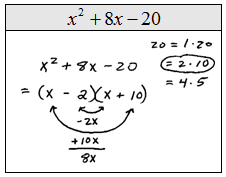How to try that? Is it possible? Is it manageable? As mention in the previous post, we condense the curriculum outcomes as much as we could. In other words, we reduce the amount of time spend on certain curriculum outcome. Like factoring trinomials,
instead of doing 20 examples on the board and every iteration possible. We did a quick review of maybe the top 4 different scenarios. Mind you that they started to learn this process in grade 9! Then we went on and tried to reduce other concepts. Instead of doing all the possible ways that could be asked about solving an equation, we showed them the major way in order to solve the majority of them. Then they would go to work. So to clarify this, we didn’t do all the examples on the board. We left the easy iteration ones out in order to leave them with a little “connecting the dots” we called it! So that students could figure it out on their own. For those who struggle what did we do? As mention in the previous post, the students who struggle started asking questions when we were circulating in the classroom. Or, they would physically move to the designated area of the classroom for extra help. That is a place to work with other students or that we would show those missing examples and review the concept.
To our surprise, we realize that we assume way too much for the students. We assume that all of them needed over 20 examples on the board and that they needed to see all the possible iteration of the concept. We assume that students would struggle with some concepts so we took a lot of time presenting. I remember teaching for almost an entire class! Which left not much time for students to “Do the Math”! After the cutback, we notice that student was making better connections or connecting the dots. Why? Because they were doing it and not us. They were connecting the dots in their own way. Which is better for understanding and mastery. Remember the old saying and still applicable today: “If you understand it, you can teach it to your younger sibling!”
Now, does it always work at 100% Absolutely NOT! Some concept is very difficult to understand mind you mastering them. So, we needed to spend more time on examples but we always tried to leave enough time during the class so that students could try a few questions. We would start the next class with time to finish the questions with us.
Then, I got interested in the “FlipClassroom“! Amazing concept and very useful. In today’s world, a lot of people consume information through video platform. They are a variety of ways to do this. I choose to create video tutorials. The student would come to class and take a Chromebook.

Then they would go to a specific link to watch it and try the example along the video. I used PlayPosit to achieve this. See the picture, that is how it looks in my class for that day. The best comment that I ever got for this platform is one of my struggling students said: “Thank you Mr. T for this, I can go at my own pace.” WOW! Another thing that we sometimes forget. “My own pace”! Some need more time.
As a group of math teachers, we realize a few things with this approach. We assume too much before actually seeing the students. We did most of the connecting the dot for them. Which didn’t help them in the long run. We really enjoyed the effect that we didn’t expect. The struggling students started to ask more questions! Win-Win in my book!
Give it a try!
Cheers,
GT
Link to the previous post, part 1.


One thought on “TED Talk vs Teaching Part 2”